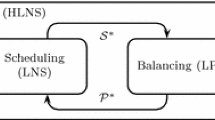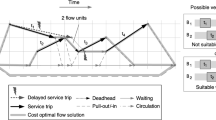Abstract
This paper examines time windows for scheduled trips in multiple depot vehicle and crew scheduling problems that arise in public bus transportation. In practice, the two planning tasks vehicle scheduling and crew scheduling are traditionally solved sequentially with the implicit understanding that the scheduled time for timetabled trips remains fixed. In order to improve cost efficiency two concepts have been developed over the last years: In order to obtain better flexibility when scheduling crews, vehicle and crew scheduling problems are tackled simultaneously. In order to extend flexibility while scheduling vehicles, variable trip departure and arrival times are considered. Obviously the combination of both concepts promises the largest savings, but probably leads to bursting computational times due to growing problem complexity.
In this paper we combine both concepts by extending the integrated vehicle and crew scheduling problem with the possibility to shift scheduled trips within defined time windows. We examine the tradeoffs between solution quality and computational time for different solution approaches.








Similar content being viewed by others
References
Bertossi AA, Carraresi P, Gallo G (1987) On some matching problems arising in vehicle scheduling models. Networks 17:271–281
Bokinge U, Hasselstroem D (1980) Improved vehicle scheduling in public transport through systematic changes in the timetable. Eur J Oper Res 5(6):388–395
Borndoerfer R, Loebel A, Weider S (2008) A bundle method for integrated multi-depot vehicle and duty scheduling in public transit. In: Computer-aided systems in public transport. Lecture notes in economics and mathematical systems, Part I, vol 600. Springer, Berlin, pp 3–24
Bunte S, Kliewer N (2009) An overview on vehicle scheduling models. Public Transp 1(4):299–317
Desaulniers G, Hickman D (2007) Public transit. In: Transportation. Handbooks in operations research and management science, vol 14. Holland North, The Netherlands, pp 69–127, Chap 2
Desaulniers G, Lavigne J, Soumis F (1998) Multi-depot vehicle scheduling problems with time windows and waiting costs. Eur J Oper Res 111(3):479–494
Desrochers M, Soumis F (1989) A column generation approach to the urban transit crew scheduling problem. Transp Sci 23(1):1–13
Desrosiers J, Dumas Y, Solomon MM, Soumis F (1995) Time constrained routing and scheduling. Handbooks in operations research and management science, vol 8. Elsevier, Amsterdam, pp 35–139, Chap 2
Fischetti M, Lodi A, Martello S, Toth P (1987) The fixed job schedule problem with spread-time constraints. Oper Res 35(6):849–858
Fischetti M, Lodi A, Toth P (1989) The fixed job schedule problem with working-time constraints. Oper Res 37(3):395–403
Fischetti M, Lodi A, Toth P (1999) A branch-and-cut algorithm for the multiple depot vehicle scheduling problem. Technical report, DEIS, Universit di Bologna, Italy
Forbes M, Holt J, Watts A (1994) An exact algorithm for multiple depot bus scheduling. Eur J Oper Res 72(1):115–124
Freling R (1997) Models and techniques for integrating vehicle and crew scheduling. PhD thesis, Erasmus University of Rotterdam, The Netherlands
Gintner V, Steinzen I, Suhl L (2006) A time-space network based approach for integrated vehicle and crew scheduling in public transport. In: Proceedings of the EURO working group on transportation (EWGT) joint conferences 2006, pp 371–377
Hadjar A, Soumis F (2009) Dynamic window reduction for the multiple depot vehicle scheduling problem with time windows. Comput Oper Res 36(7):2160–2172
Huisman D (2004) Integrated and dynamic vehicle and crew scheduling. PhD thesis, Erasmus University of Rotterdam, The Netherlands
Huisman D, Freling R, Wagelmans AP (2005) Multiple-depot integrated vehicle and crew scheduling. Transp Sci 39(4):491–502
Keri A, Haase K (2008) Simultaneous vehicle and crew scheduling with trip shifting. In: Operations research proceedings 2007. Springer, Berlin, pp 467–472
Kliewer N, Mellouli T, Suhl L (2002) A new solution model for multi-depot multi-vehicle type vehicle scheduling in (sub)urban public transport. In: Proceedings of the 13th Mini-EURO conference and the 9th meeting of the EURO working group on transportation (EWGT). Politecnico of Bari, Bari
Kliewer N, Mellouli T, Suhl L (2006a) A time-space network based exact optimization model for multiple-depot bus scheduling. Eur J Oper Res 175(3):1616–1627
Kliewer N, Bunte S, Suhl L (2006b) Time windows for scheduled trips in multiple depot vehicle scheduling. In: Proceedings of the EURO working group on transportation (EWGT) joint conferences 2006, pp 340–346
Kliewer N, Gintner V, Suhl L (2008) Line change considerations within a time-space network based multi-depot bus scheduling model. In: Proceedings of 9th international conference on computer-aided scheduling of public transport (CASPT), pp 57–70
Loebel A (1999) Solving large-scale multiple-depot vehicle scheduling problems. In: Lecture notes in economics and mathematical systems (LNEMS). Computer-aided transit scheduling, vol 471. Springer, Berlin, pp 193–220
Mesquita M, Paias A (2008) Set partitioning/covering-based approaches for the integrated vehicle and crew scheduling problem. Comput Oper Res 35(5):1562–1575
Mesquita M, Paias A, Respicio A (2009) Branching approaches for integrated vehicle and crew scheduling. Public Transp 1(1):21–37
Mingozzi A, Bianco L, Ricciardelli S (1995) An exact algorithm for combining vehicle trips. In: Proceedings of the 6th international workshop on computer aided scheduling of public transport (CASPT), pp 145–172
Pepin A-S, Desaulniers G, Hertz A, Huisman D (2009) A comparison of five heuristics for the multiple depot vehicle scheduling problem. J Sched 12(1):17–30
Portugal R, Lourenço HR, Paixao JP (2009) Driver scheduling problem modelling. Public Transp 1(2):103–120
Ribeiro C, Soumis F (1994) A column generation approach to the multiple-depot vehicle scheduling problem. Oper Res 42(1):41–52
Steinzen I (2007) Topics in integrated vehicle and crew scheduling in public transit. PhD thesis, University of Paderborn, Germany
Steinzen I, Gintner V, Suhl L, Kliewer N (2010) A time-space network approach for the integrated vehicle- and crew-scheduling problem with multiple depots. Transp Sci 44(3):367–382
Author information
Authors and Affiliations
Corresponding author
Rights and permissions
About this article
Cite this article
Kliewer, N., Amberg, B. & Amberg, B. Multiple depot vehicle and crew scheduling with time windows for scheduled trips. Public Transp 3, 213–244 (2012). https://doi.org/10.1007/s12469-011-0049-6
Published:
Issue Date:
DOI: https://doi.org/10.1007/s12469-011-0049-6




